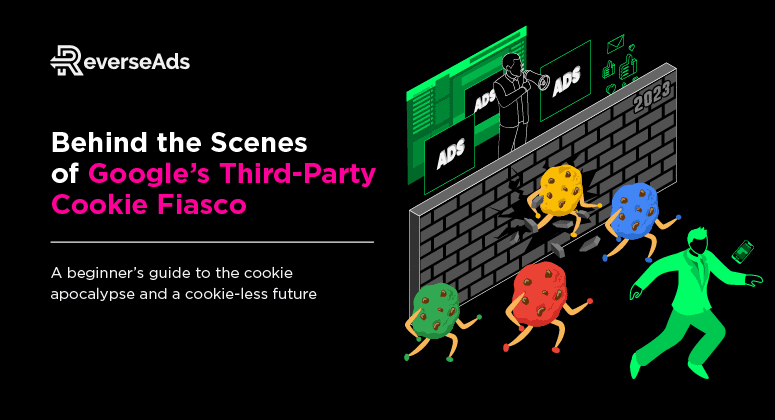Behind the Scenes of Google’s Third-Party Cookies Fiasco

A Beginner’s Guide to The Cookie Apocalypse and a Cookie-less Future
In June 2021, Google announced that it is delaying its plans to phase out third-party cookies in Chrome until 2023, two years later than originally planned. Although few would shed tears over Google as the company attempts to rework online ad targeting amidst the scrutiny of regulators and advertisers, finding a way to balance conflicting incentives between user privacy and Google’s dominance in the ad space has great repercussions for the rest of us.
As ad tech stocks surged after Google made its announcement, it’s also becoming clearer that more time is needed across the digital advertising ecosystem to plan for privacy-conscious targeted ads; we are also witnessing more ad tech companies coming up with tools to mitigate workarounds.
Down The Rabbit Hole of The Cookie Apocalypse
In 2016, the European Union (EU) passes the General Data Protection Regulation (GDPR) which requires websites to get users’ consent before tracking them with cookies. Safari started to block some third-party cookies through the first iteration of its Intelligent Tracking Prevention (ITP) protocol in 2017.
Both Firefox and Safari now blocks all third-party cookies by default with enhanced tracking protection features. There has since been a 40% decrease in third-party cookies since Apple and Firefox made changes to their browsers. Google Chrome was the last to join the bandwagon in 2020 by announcing that it will block all third-party cookies within two years starting with its Privacy Sandbox initiative to “develop and test new browser features that would boost user privacy.”
Prior to cookies, the web had no method of remembering a user at all, with the exception of logging in again directly. When Lou Montulli (founding engineer of Netscape) invented the cookie in 1994, he meant to create a way for websites to remember information about visitors who had previously visited them.
Cookies were originally designed to prevent tracking, because only the originating website can set and receive that cookie. What none of the early browser inventors anticipated, however, was the ability of other websites and services to insert their own cookies onto a browser whenever someone visited a specific website or viewed specific content. Combined with other web technologies, so-called “third party cookies” could track users even if they weren’t on the originating website – the rest of the world figured out how to exploit the system.
The argument made for not killing third-party cookies was that it fueled advertising – the main revenue stream of websites. By turning off advertising cookies, it would severely diminish the ability for revenue to be made on the web. At the time, the tech industry’s priority was to maintain a revenue model to make the web successful so the choice was to try to give cookie options to the user, but not to disable them entirely.
Interestingly, a study in 2016 found that while using more information from cookies increases the accuracy of prediction of purchases, it was at a decreasing rate. In estimating the effect of an ad on a user’s purchase probability, researchers found that on average, ads do not have a statistically significant impact on purchase probabilities of consumers. However, individuals who have a high baseline purchase probability, do respond positively to ads and ads can increase their purchase probability by up to 2.7%.
Simply put, the likelihood that a person will buy something from an ad that uses cookies compared to one that does not, has been overstated – so to speak. Cookies are neither that accurate nor useful, and in fact the tide against third-party cookie tracking has helped us to rethink what data really matters.
What is a Browser Cookie?
Back in the late 1990s, like a waiter who can’t recall who ordered the beef burger with extra cheese, the internet back then had no memory of who did what. Sites had no way to know you were a returning visitor, or even to record when you visited another one of its many pages.
Cookies are small pieces of code that websites deliver to a visitor’s browser and stick around as the person visits other sites. It helps the website remember information about you—often for benign reasons, like remembering your login credentials or making sure the items in your shopping cart will still be there even if you close the page and come back later.
It was initially designed to maintain your privacy and your security; that little bit of text wasn’t software code and it didn’t know your name or what you did elsewhere on the web. It just knew that the browser in your computer had once visited that particular website, so it could be referred to if you returned.
That modest computer cookie has now evolved into something far more nefarious. It can be used to track users across multiple sites to target ads and see how they perform – and sits at the center of a multibillion dollar digital ad industry that has taken over the world.
What’s The Difference Between Third-Party and First-Party Cookies?
Cookies that come directly from a website you chose to visit are called first-party cookies. For example, if you visit an e-commerce site and type in your shipping address to get a shipping fee estimate, the site might save a cookie on your device. That way, it will remember your location—and offer the right recommendations more quickly—the next time you visit.
When cookies come from someplace other than the website you chose to visit, they’re called third-party cookies. For example, if you go to the ESPN website that displays a gambling ad, that ad might save a cookie on your computer that reports back to the advertiser. The cookie then marks you as the person who saw this particular ad at this particular moment. If at some point later you visit the advertiser’s website and bet on a cricket match, the company can infer that its marketing campaign influenced your decision and was effective.
Advertisers use third-party cookies to measure how well their campaigns are performing, gather data on your interests, and target ads to specific audiences. As mentioned earlier, there hasn’t been any conclusive evidence that all this tracking actually gets consumers to spend more money on products—but it does get businesses to spend more on advertising. That extra spending has propped up a thriving industry (read: Google) dedicated to harvesting your data through third-party cookies.

Three-step marketing survival guide for a cookie-less future:
1.Understanding precisely how third-party cookies power your business: Do you know who your target audience is? What about their demographics, interests, wants, and needs when it comes to engaging with your brand?
- If you’ve been relying on capturing this type of information from cookies, now is the time to make sure you truly know more of your customer than ever before.
2.More first-party data conversion data means better measurement: First-party cookies aren’t used for ad tracking and they aren’t going away. The data you do have about your customers via first-party data should become the foundation of your advertising efforts moving forward.
- Businesses should optimize first-party tracking as an effective alternative to connect with more of the right customers. For example, publishers and advertisers each collect their own data about their audience and consumers respectively. If a brand and a publisher have the same piece of information about you, like your email address, they can team up to match your spending habits on the brand’s site to your reading habits on the publisher’s site and target ads even more effectively.
- Focus on growing your audience by putting strategies in place to increase your subscriber base, email list, and engaged followers on social media. You can then serve these audiences with personalized content through other forms of advertising that don’t require in-depth data collection.
3.Identify the right ad tech tools to replace third-party cookies: There has been a few initiatives for how the advertising industry can continue to show consumers relevant ads and measure the effectiveness of marketing campaigns without relying on third-party cookies. The following tools and systems aren’t mutually exclusive as the industry continues to experiment with new technologies to replace legacy, data-intensive mechanisms.
- Google’s Privacy Sandbox, Federated Learning Cohorts (FLoC) model: The browser tracks users and groups them into cohorts alongside thousands of peers with similar online habits. Every time you visit a website, your browser tells the site which cohort you belong to, and advertisers show you ads tailored to people with similar interests.
- Unique ID or identity-based tracking: A central authority would assign every web user an advertising ID that advertisers could track every time users log onto a website. Marketers will be able to monitor users’ browsing habits, serve targeted ads, and measure whether they decided to purchase the advertised product or service after seeing an ad.
- ReverseAds “Keyword Road Mapping” algorithm”: ReverseAds’ tracking solution focuses on privacy by predicting a user’s path to purchase, without the use of cookies. Our algorithm tracks campaign-level engagement data specifically tied to intent on a keyword specific to a particular user. This means that the information stored is anonymous and yet advertisers are able to read engagement specific to that user. It also works across all modern browsers and is not affected by Apple’s ITS or Chrome 3rd Party Cookie blocking.
For more information on the ReverseAds’ privacy-first tracking solution, email info@reverseads.com or connect with us via Facebook and LinkedIn.





